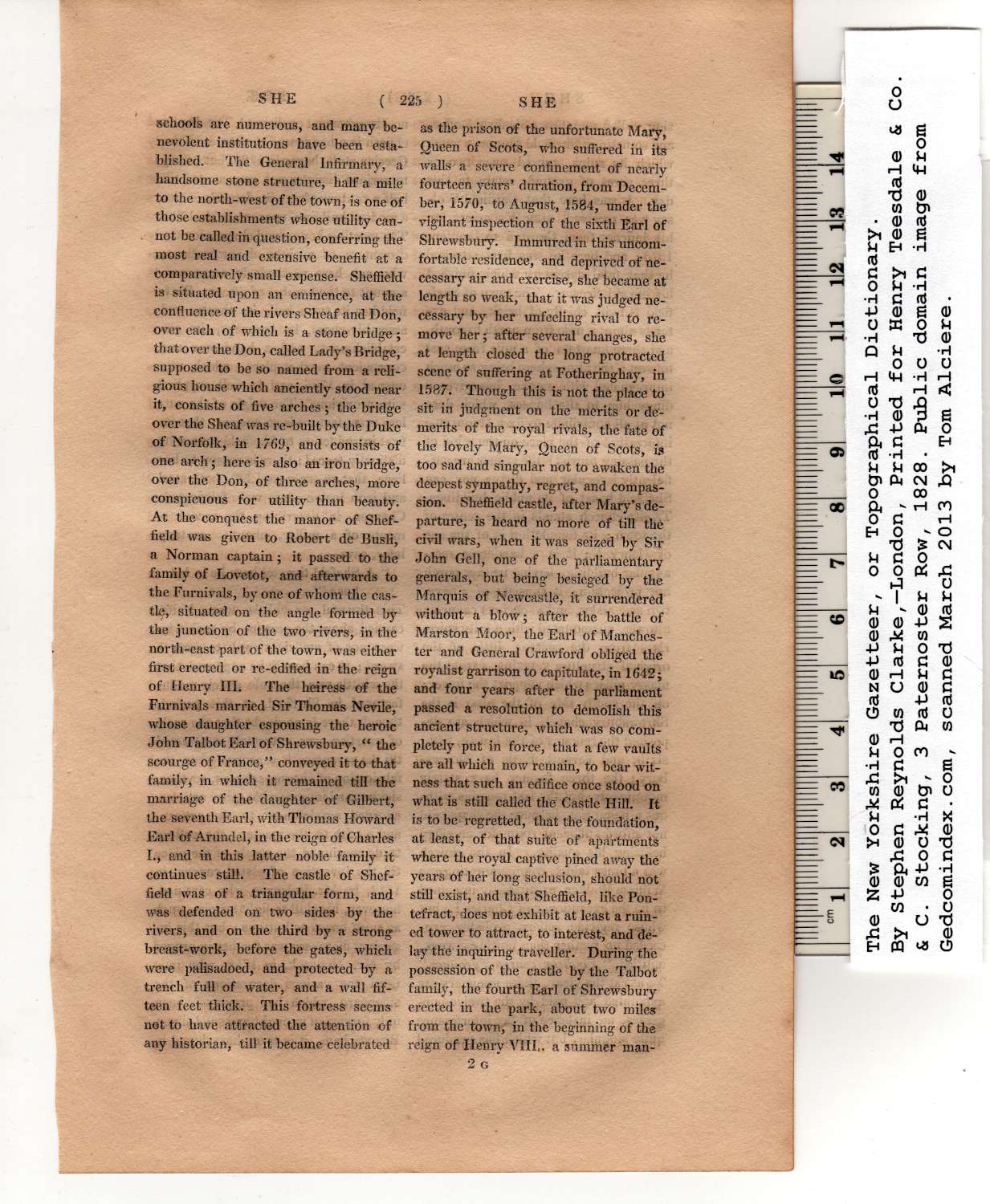|
schools are numerous, and many be-
nevolent institutions have been esta-
blished. The General Infirmary, a
handsome stone structure, half a mile
to the north-west of the town, is one of
those establishments whose utility can-
not be called in question, conferring the
most real and extensive benefit at a
comparatively small expense. Sheffield
is situated upon an eminence, at the
confluence of the rivers Sheaf and Don,
over each of which is a stone bridge ;
that over the Don, called Lady’s Bridge,
supposed to be so named from a reli-
gious house which anciently stood near
it, consists of five arches; the bridge
over the Sheaf was re-built by the Duke
of Norfolk, in 1769, and consists of
one arch; here is also an iron bridge,
over the Don, of three arches, more
conspicuous for utility than beauty.
At the conquest the manor of Shef-
field was given to Robert de Busli,
a Norman captain; it passed to the
family of Lovetot, and afterwards to
the Furnivals, by one of whom the cas-
tle, situated on the angle formed by
the junction of the two rivers, in the
north-east part of the town, was either
first erected or re-edified in the reign
of Henry III. The heiress of the
Furnivals married Sir Thomas Nevile,
whose daughter espousing the heroic
John Talbot Earl of Shrewsbury, “ the
scourge of France,” conveyed it to that
family, in which it remained till the
marriage of the daughter of Gilbert,
the seventh Earl, with Thomas Howard
Earl of Arundel, in the reign of Charles |
I., and in this latter noble family it
continues still. The castle of Shef-
field was of a triangular form, and
was defended on two sides by the
rivers, and on the third by a strong
breast-work, before the gates, which
were palisadoed, and protected by a
trench full of water, and a wall fif-
teen feet thick. This fortress seems
not to have attracted the attention of
any historian, till it became celebrated
as the prison of the unfortunate Mary,
Queen of Scots, who suffered in its
walls a severe confinement of nearly
fourteen years’ duration, from Decem-
ber, 1570, to August, 1584, under the
vigilant inspection of the sixth Earl of
Shrewsbury. Immured in this uncom-
fortable residence, and deprived of ne-
cessary air and exercise, she became at
length so weak, that it was judged ne-
cessary by her unfeeling rival to re-
move her; after several changes, she
at length closed the long protracted
scene of suffering at Fotheringhay, in
1587. Though this is not the place to
sit in judgment on the merits or de-
merits of the royal rivals, the fate of
the lovely Mary, Queen of Scots, is
too sad and singular not to awaken the
deepest sympathy, regret, and compas-
sion. Sheffield castle, after Mary’s de-
parture, is heard no more of till the
civil wars, when it was seized by Sir
John Gell, one of the parliamentary
generals, but being besieged by the
Marquis of Newcastle, it surrendered
without a blow; after the battle of
Mars ton Moor, the Earl of Manches-
ter and General Crawford obliged the
royalist garrison to capitulate, in 1642;
and four years after the parliament
passed a resolution to demolish this
ancient structure, which was so com-
pletely put in force, that a few vaults
are all which now remain, to bear wit-
ness that such an edifice once stood on
what is still called the Castle Hill. It
is to be regretted, that the foundation,
at least, of that suite of apartments
where the royal captive pined away the
years of her long seclusion, should not
still exist, and that Sheffield, like Pon-
tefract, does not exhibit at least a ruin-
ed tower to attract, to interest, and de-
lay the inquiring traveller. During the
possession of the castle by the Talbot
family, the fourth Earl of Shrewsbury
erected in the park, about two miles
from the town, in the beginning of the
reign of Henry VIIU. a summer man-
2 G |
